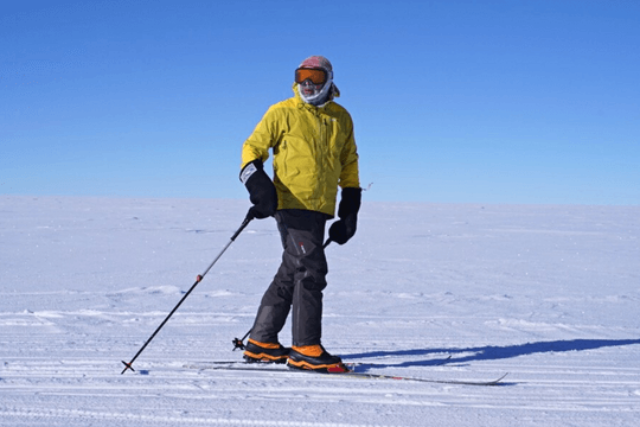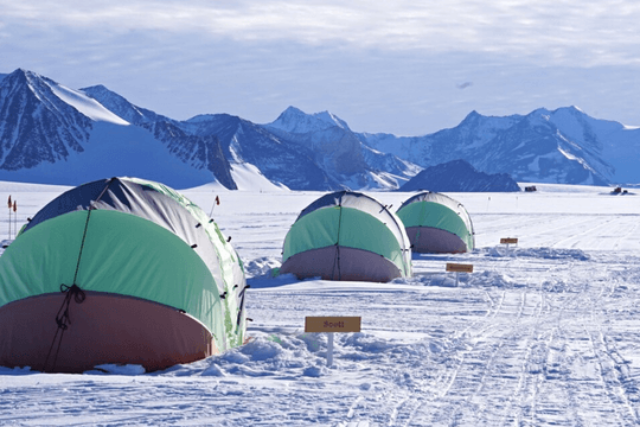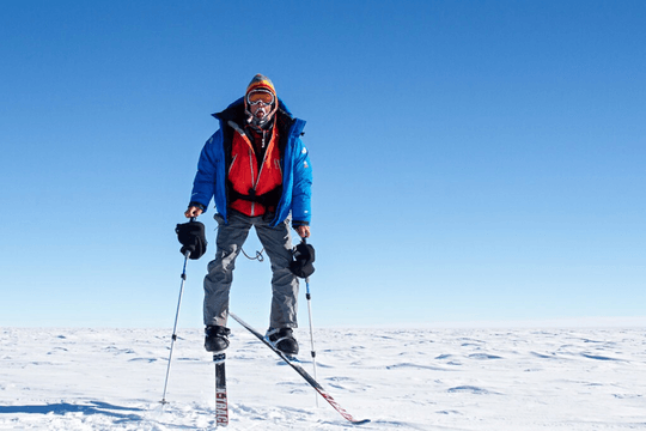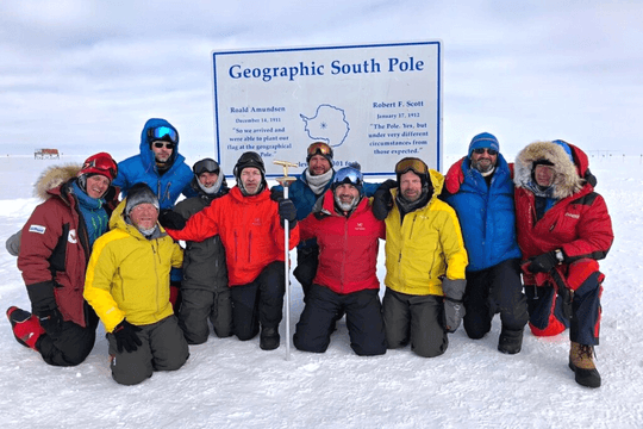Can You Go to the South Pole?
It’s the driest, coldest and most uninhabitable place on Earth, and yet it’s been attracting adventurers and explorers for centuries. Do you have what it takes to discover the White Continent? Choose the perfect adventure that suits your explorer’s spirit. And don’t worry, you don’t need to endure the hardships of the historic explorers to visit the South Pole!

History of Expeditions
For centuries, explorers kept venturing to the Earth’s polar regions to discover terra incognita. Read on to get a brief history of the White Continent and the discovery of the South Pole:
- February 19th, 1819: William Smith explores the Southern Ocean and spots land south of 60 degree south latitude (the South Shetland Islands, just 120 km/75 miles off the Antarctic Peninsula).
- January 27/28th, 1821: Fabian Gottlieb von Bellingshausen and Mikhail Lazarev confirm the sighting of mainland Antarctica.
- February 7th, 1821: Captain John Davis claims to have set foot on the continent.
- 1897 – 1899: The Belgian Antarctic Expedition, led by Adrien de Gerlache de Gomery with famous team members such as Roald Amundsen aboard, becomes the first expedition to spend the winter in Antarctica stuck in pack ice aboard the Belgica, south of the Antarctic Circle.
- February 4th, 1902: Robert Falcon Scott becomes the first person to see Antarctica and its interior from a bird’s-eye view in a hot air balloon. Sir Ernest Shackleton later ascends in that same balloon to snap the first pictures of the continent from above.
- January 16th, 1909: Douglas Mawson, Edgeworth David and Alistair Mackay reach the magnetic South Pole.
- December 14th, 1911: Roald Amundsen’s expedition reaches 90 degrees south.
- January 17th, 1912: Robert Falcon Scott’s party reaches the South Pole.
- 1956 - 1957: The Amundsen-Scott South Pole Station is established.
- March 2nd, 1958: Vivian Fuchs becomes the first person to cross the Antarctic continent in 99 days, travelling 3,473 km (2,158 miles).
- December 18th, 1966: A team of Americans led by Nicholas Clinch becomes the first to climb Mount Vinson, the highest peak in Antarctica.

South Pole Camps
How do real explorers live and survive in Antarctica? Get a feel for it and spend some unforgettable nights at one of the camps in interior Antarctica. And don’t worry, you’ll be positively surprised by how comfortable modern camps can be!
South Pole Camp
It’s not going to be a cold night, even though you’ll sleep just 1 km (0.6 miles) from the geographical South Pole. Heated double walled sleeping tents will keep you warm and comfortable, while delicious meals are served in a heated dining tent. While toilet facilities are available, there will be no showers at this camp. There is lots to see, like the annually changing South Pole marker, the visitor center and the Amundsen-Scott base.
Union Glacier Camp
Some of the most exciting interior Antarctica expeditions start here! This tented camp offers accommodation for up to 70 people. You’ll meet the most interesting explorers from all over the world, such as climbers heading to Mount Vinson or teams cross-country skiing onwards to the 90 degrees south. Enjoy meals at the camp (or a picnic lunch when exploring the area), daily adventures and excursions with tracked vehicles, blue ice photography, cross-country skiing, movies, games and a polar library. A popular excursion you shouldn’t miss is the Drake Icefall. This impressive icefall tumbles into the Union Glacier off the polar plateau.

How to reach the South Pole
Can you go to the South Pole even if you are not a hardcore adventurer or attempting scientific research? Before the 1960s you’d likely have to have be a real explorer or whaler to make it to Antarctica, but for the last 60+ years (after the Antarctic Treaty was signed in 1959) regular tourists started Antarctic exploration. While you can visit the shores and the Antarctic Peninsula by ship, you cannot sail to the 90 degrees south, as it’s land-locked at the interior of the continent. The easiest way to reach the pole is via plane from Punta Arenas in Chile, with a stopover at Union Glacier Camp. And, if you’re really adventurous, sign up for an epic cross-country ski expedition to cover the distance from Union Glacier Camp to the South Pole on foot!
Flying to the South Pole
Can you go to the South Pole in comfort, without being exposed to extreme hardship and physical efforts? You can if you fly! Antarctic travel has never been more comfortable. Planes that fly to Antarctica are real work horses equipped for extreme conditions (there is even such a thing as a ski aircraft that has skis instead of regular landing gear). Your trip starts in Punta Arenas (South America) taking a plane to Union Glacier camp on the White Continent. From there you’ll continue by plane to reach the pole in ca. 4-5 hours. There are several tour operators offering different packages (including options to overnight at the South Pole camp). This is a perfect option for explorers who opt for a little more comfort and do not wish to cover the distance from Union Glacier to the pole on skis.

Skiing to the South Pole
Want to reach the 90 degree south just like real polar explorers did back in the day? Ski the last degree (or more) by joining an epic expedition under real Antarctic conditions. This trip is not for the faint hearted or unprepared explorer and is only possible with experienced guides. Starting at Punta Arenas airport, you’ll be airlifted (if runway conditions permit) to Union Glacier base camp. Some expedition operators offer various itineraries starting e.g. from Reedy Glacier (with a total route of 650 km/400 miles), Leverett Glacier (578 km/360 miles) or North Berkner Island (with a total of 1,349 km/838 miles to the pole).
Equipped with cross-country skis, sleds, tents, sleeping bags and padded sleeping mats, you’ll embark on your once-in-a-lifetime adventure to reach the geographic South Pole. Like real Antarctic explorers, you’ll spend the night in tents, before returning by plane to Union Glacier camp and eventually to Punta Arenas. While this is a very strenuous way to explore the pole, this trip will give you a real expedition experience.
What can I expect to encounter at the South Pole?
If you find yourself at the geographic South Pole, you’ll likely be visiting the Amundsen-Scott South Pole station. At the exact location, you will find a marker (marking the southernmost point of Earth), which changes every year! This ceremonial pole marker is placed at exactly 90 degrees South by scientists every January 1st since 1959 (the exact location shifts each year with the rotation of the Earth’s axis). Every year the unveiling of the pole marker is highly anticipated, as the overwintering crew at the Amundsen-Scott station utilizes all of its creativity designing it. Want to see how a research station in such an extreme environment works? Get a welcome tour – visitors are allowed to tour the station. And did you know that you can even spend the night at the South Pole camp? Companies like Antarctic Logistics offer visitors the chance to fly to the polar plateau for a unique overnight stay. Enjoy incredible views of the station’s buildings surrounded by the bleak landscapes of the White Continent. You will approach by air, see the endless expanse of Antarctica from above and land on a blue ice runway.
FAQ
Is it legal to go to the South Pole?
Yes, but you will need a permit to set foot on the White Continent. If you travel as part of an expedition, your tour operator will arrange all the formalities for you.
What’s the weather like?
Expect extreme cold with average temperatures of -49 C (-56 F). While Antarctica itself is the windiest continent on the planet, you won’t experience the worst of it directly at the pole because it is located on a flat high polar plateau. The maximum wind speed recorded was only 50 knots (93km/h or 58mph).
Which pole is colder?
The South Pole is colder due to its location on land and at a higher elevation than the North Pole (which is located in the ocean at sea level.
What wildlife can you find at the South Pole?
There are no animals right at the pole or in the interior of the Antarctic continent. You can find wildlife (e.g. marine mammals, birds) in coastal areas. The furthest south animal living on Earth is the emperor penguin, which can breed up to 18 km (11 mi) off the Antarctic shores.
